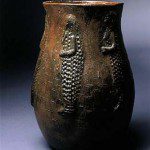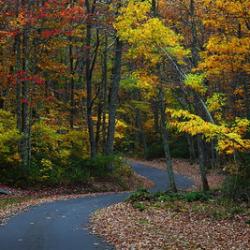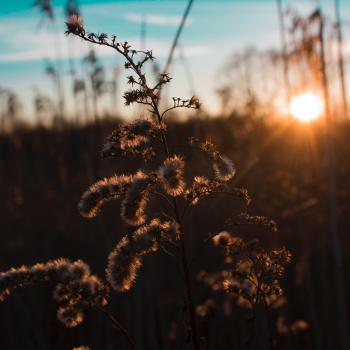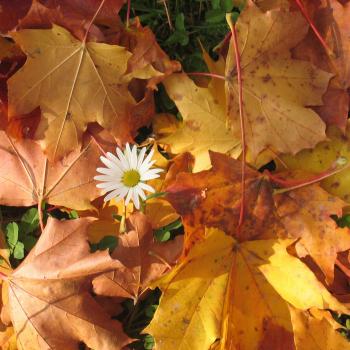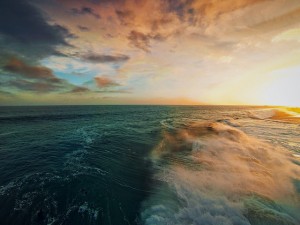
Almost every religious tradition has a creation mythology or genesis story about the triumph of order, light and civilization over the powers of confusion, darkness and wilderness. Though details differ from culture to culture and era to era, many of the themes are remarkably similar:
- the churning waters of chaos in which all substances are intermingled and indistinguishable;
- the first divine act (a breath, a coupling, a hatching, a birth) that begins the process of separation;
- the death or dismemberment of a deity to create the very stuff of the universe.
As people living in a modern society informed by the discoveries of science, we have a tendency to think of these cosmogonic (literally, “order-begetting”) myths as made-up stories that our ancestors turned to for explanation in their ignorance of the facts. Particular creation myths might be moving, beautiful or meaningful for us, and so true in some deeply metaphorical way, but most of us shy away from claiming that these stories must therefore be factual accounts of what actually happened. Instead, science offers us evidence in support of theories like evolution and the Big Bang to explain how the world came into existence and life evolved into the myriad species we see today.
But what if science uncovered evidence that these ancient creation stories might just have gotten some of the facts right after all? That’s looking more and more likely, according to geneticists seeking clues to the origin of life on this planet in the shared genetic traits of plants, animals, bacteria and the microorganisms known as archaea. Piecing together the puzzle of evolution over the past several billion years, scientists now believe that our last common ancestor may have been a planet-wide “mega-organism” so huge that it was the size of the sea itself.
Scientists Meet Mother Ocean
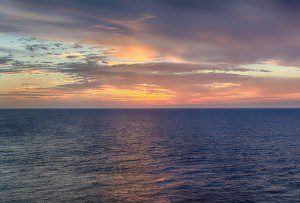
From the beginning, evolutionary biologists have postulated that all of the organisms currently living on the planet must have originated from a single shared ancestor — a theory that recent statistical analysis now confirms is more probable than there being multiple ancestors by a factor of 10^2860. Scientists call this great-great-grandparent organism from which all current life descends LUCA, or the Last Universal Common Ancestor, and estimate that it lived between 2.9 and 3.8 billion years ago.
Since very little evidence remains to show what kind of beings lived in the ancient seas of our young planet, genetic researchers have had to piece together the lingering traces of similarities in molecular structure shared among the three domains of life: single-celled archaea, bacteria and multicellular eukaryotes (plants, animals, fungi and the rest). The details get pretty technical (if you want to know more, check out this article in Science Daily), but the long and short of it is that scientists now have a pretty clear picture of what LUCA might have looked like.
What does that picture show? Something pretty startling. Billions of years ago, life existed as a primordial living soup that used the oceans as its medium, spanning the entire planet in what scientists are calling a “mega-organism.” (Think: the leviathan from the Illuminatus! trilogy or, better still, the living ocean of the planet Solaris in the novel of the same name.)
The latest research suggests LUCA was the result of early life’s fight to survive, attempts at which turned the ocean into a global genetic swap shop for hundreds of millions of years. Cells struggling to survive on their own exchanged useful parts with each other without competition – effectively creating a global mega-organism.
LUCA’s cells lacked the specialized molecular structures of cells today which allow them to efficiently and precisely control the production of the proteins they need for survival. However, those ancient cells did have primitive organelles and the basic enzymes necessary to break down and process nutrients, as well as the ability to build proteins in a clumsy, hit-or-miss kind of way. They also had “leaky” membranes that made the exchange of genetic material much easier, encouraging cooperation and coexistence rather than competition among cells.
That’s why LUCA had to be cooperative, with any cells that produced useful proteins able to pass them on throughout the world without competition. This was a weird variation on what we know as natural selection — helpful proteins could go from a single cell to global distribution, while harmful or useless proteins were quickly weeded out and discarded. The result was the equivalent of a planet-spanning organism.
This latest research puts a new twist on evolutionary biologists’ assumptions about “survival of the fittest” among primitive life on the planet. Rather than a single-celled organism that slowly evolved into a multicellular structure in order to gain the competitive edge over other early forms of life, it now seems likely that LUCA began as a vast, multicellular organism that thrived through cooperation and interdependence, breaking up into different entities as its parts became increasingly self-sufficient. Today’s bacteria are not more complex or sophisticated than LUCA’s cells; they are actually simpler and more streamlined.
Ancient Myth Meets Modern Science
So what did the old creation myths get right? Almost every culture in the world has a cosmogonic story that shares one or more of these themes: the primordial waters of chaos, the separation of substances into their complimentary (and competing) opposites, and the dismemberment of a god or other being from which the world itself is made. Each of these three themes can serve as a pretty accurate metaphor for what scientists now believe to be the factual history of how life evolved on earth.
Chaotic Waters
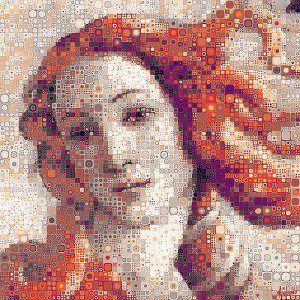
The dark waters and murky depths of the ocean have long held sway over the human imagination as the realm of confusion, disintegration and mystery as well as the source of creation and life. The ancient Babylonian creation myth describes a primordial goddess of chaos named Tiamat, who held the other gods — as well as the yet-unnamed sky and earth — within her body where “their waters were mingled together.” In the Judeo-Christian genesis story, the creator god Yahweh moves across the face of the roiling waters before speaking the single word that will part them to create heaven and earth. Similarly in ancient Egyptian mythology, life is said to have arisen out of the lifeless, watery abyss (deified as Nu), and in both Greek and Norse mythology the wellspring of creation exists within a dark void of nothingness from which the first waters of life spring.
In Japanese mythology, the story is told of how the two spouse-sibling deities Izanagi and Izanami plunged a jeweled spear into the thick soup of the ocean and stirred until the briny substance congealed into islands, forming the archipelago of Japan. Nearby in China, it is said the primordial giant P’an-ku formed inside a cosmic egg in which all the stuff of the universe was mixed up together, and that as he grew, he cracked the egg open and divided its shell and inner mixture into the opposites of yin and yang, earth and sky, male and female, and so on. In their own way, each of these myths evoke the sense of life appearing from the dark, chaotic depths of undifferentiated form where all substances mix and mingle together. One could hardly find a better description for what life must have been like in the earth’s oceans some 3 billion years ago.
Separation and Competition
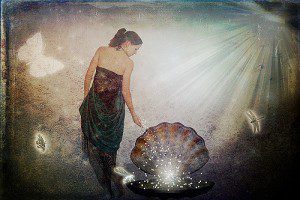
In several of these myths, we can also see the recurring theme of the separation of these chaotic, intermingling waters into distinct elements that both compliment and compete with each other. Gods like Yahweh, P’an-ku and Atum are said to have divided this basic formless stuff of the world into opposites like heaven and earth, land and sky, male and female, light and dark, day and night, sun and moon. In Greek mythology, out of the void of Chaos comes Gaia (earth), along with Tartarus (abyss) and Eros (love) — or in other words, both separation and space, and the potential for attraction and relationship between distinct beings.
Sometimes this separation is an act of masturbation, while other stories describe it as a birth. In some cases — such as in the Chinese story of P’an-ku, the Hiraṇyagarbha (“Golden Egg”) of Brahma in Hindu cosmology, and in some versions of the Egyptian creation story — the birth takes the form of hatching from the cosmic egg. In Polynesian mythology, the earth-goddess Papa creates the oceans when her belly swells so full of water that they suddenly burst forth, giving birth to the sea god Tangaroa, who proceeds to separate his mother earth from her lover, the sky (Rangi). Besides being a separation of the offspring from the mother, such a divine birth often results in the separation of primordial gods into male and female pairs. Egyptian mythology holds that Geb (earth) was joined in eternal sexual union with Nut (sky) until their offspring Shu (air, or emptiness) came between them and forced them apart. In Greek mythology, the machinations and betrayals of the father by a son who sides with his mother is a theme that recurs through several generations of deities.
These stories of separation, division and distinction strongly echo what scientists think might have been the reality of LUCA’s fate, as this planet-sized, oceanic mega-organism broke apart into individuated, self-sufficient entities capable of surviving on their own. With this new independence came an end to the playground of free genetic exchange, and in its place arose competition and the more familiar process of natural selection as we know it today. Ancient myths of divine sibling rivalry and conflict seem especially poignant in light of such scientific theories.
Dismembered Gods
Finally, another common element in many creation stories is the dismemberment and scattering of a divine being’s body to create the very stuff of the universe. In Norse mythology, the frost giant Ymir and the giant cow Auðumbla are both born of the commingling of opposite elements in the life-giving moisture called eitr, which formed when the congealed rime of the icy realm of Niflheim fell through the void into the fiery realm of Muspelheim where it melted and joined with sparks of flame. The sons of Auðumbla’s offspring eventually rise up to kill Ymir and dismember his body to create the world. His blood becomes the sea, his bones make the mountains and his skull becomes the sky. In a similar story in Babylonian myth, the primordial sea-goddess and mother of creation Tiamat plots to kill her own descendants, but they discover her plans and eventually her great-great-grandson, Marduk, defeats her in battle, cutting her body in half. He uses one half to create the earth and the other to make the sky, while her tears became the source of the Tigris and Euphratus rivers. From the blood of her consort, Kingu, Marduk created the first human beings. Both of these creation myths are arguably further examples of the male and female separating from a single undifferentiated substance, with their divine offspring or descendants eventually rising up to set against the parents.

Another example of the dismembered god can be found in Hindu cosmology, which tells the story of Purusha, a primeval giant chosen by the gods as a sacrifice from whom they make the world. His feet become the earth and his head the sky, his breath is the wind, his eyes are the sun and his mind becomes the moon. The four castes of Indian society were also said to have been made from Purusha’s body. And last but not least — in ancient Chinese mythology, after being born in the nourishing soup of the cosmic egg and separating the elements into their opposites, our old friend P’an-ku finishes his act of creation by bursting apart his own body to create the ten thousand things: his eyes become the sun and moon, his head the sacred mountains, his blood makes the rivers, his hair becomes the grass, his breath the wind and his voice the thunder.
In these tales — and in particular stories about how new living creatures and the very existence of human beings themselves are formed from the corpse of a god or giant — we can see clear parallels with the literal “dis-membering” of LUCA from a single mega-organism into disparate creatures of specialized and competing interests. From the ancient unity of this great mother ocean was born, quite literally, the ten thousand (and more!) things.
Ancestor Worship Just Got Nerdy
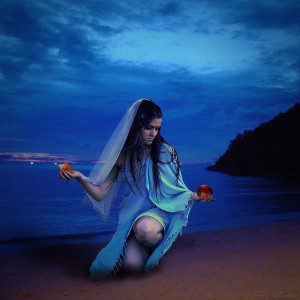
Many modern Pagans and polytheists honor the ancestors of their bloodlines and homelands alongside the gods and goddesses of pre-Christian peoples. With the genetic theory of LUCA evolving (no pun intended!) in new and exciting directions, we can see how scientifically viable facts can sometimes support the poetry and insight of the old stories. The possibility of a living mother ocean as our Last Universal Common Ancestor not only blurs the lines between ancestor and deity reverence, but also challenges us to keep a more open mind about the ways in which science and religion can shape and inform each other.
So next time you’re relaxing to the soothing sounds of the ocean’s tides, or marveling at the amazing diversity and interdependence of life on this planet, take a moment to say a prayer for our vast and clumsy Grandmother LUCA, as old and deep as the sea.



